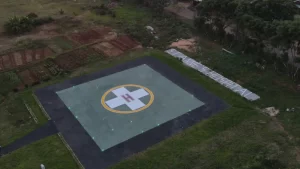ST ANNE’S IS A PRIVATE ROMAN CATHOLIC HEALTH FACILITY LOCATED IN AVONDALE, HARARE. IT WAS STARTED 1937 BY THE CATHOLIC SISTERS OF THE LITTLE COMPANY OF MARY. THE HOSPITAL HAS VARIOUSDEPARTMENTS WHICH INCLUDES OPERATING THEATRES (OTS), INTENSIVE CARE UNIT (ICU), CORONARY CARE UNIT (CCU), HIGH DEPENDENCY UNIT (HDU), EXECUTIVE EN SUITES, PRIVATE SINGLE ROOMS, GENERAL WARDS AND THE PAEDIATRIC UNIT. THEIR BED CARRYING CAPACITY IS ABOVE 100. THE HOSPITAL IS A THREE STOREY STRUCTURE. ST ANNE’S HOSPITAL HAS BEEN INSTRUMENTAL IN THE ESTABLISHMENT OF SEVERAL SISTER HOSPITALS INCLUDING MT. ST MARY’S HOSPITAL IN WEDZA, ST PETER’S MISSION HOSPITAL IN CHECHECHE (CHIPINGE), MURAMBINDA MISSION HOSPITAL IN BUHERA AND MASHAMBANZOU CARE TRUST IN HARARE.52
In 2021 St Anne’s commissioned local company Distinct Design and Construction (DDC) to design and build a brand new helipad on the hospital grounds. Work on the project started in September 2021 and construction was mostly completed by the end of November the same year. Relevant authorities were engaged to ensure compliance with regulatory requirements.
These include the Environmental Management Agency (EMA) and the Civil Aviation Authority of Zimbabwe (CAAZ). After clearing and levelling the site approximately 1 metre of soil was removed. Preparing the site for the concrete slab involved installing four layers of sand and gravel which were each hydraulically compacted and rigorously tested before the next layer could be added. The surface layer is 300mm to 500mm of grade 35 concrete, usually used for pile foundations, with a lattice work of 12mm deformed steel bars for extra reinforcement. The concrete premix was supplied by Scribante – about 40 loads of 6-8 tonnes each – and cast in 3.8m2 sections with expansion joints in between.
The slab took about 28 days to fully cure and had to be periodically hosed down with water to ensure it reached the correct strength and didn’t harden too fast and crack which would have compromised the final integrity and strength. The helipad structure was designed in accordance with specifications from the Civil Aviation Authority of Zimbabwe (CAAZ) and can support a load of up to 60 tonnes. There’s also a backup power supply so the landing pad can be used at night even when there’s no electricity. CAAZ has installed the radio communication system for air traffic control as well as a windsock to help guide the pilots’ landing and take-off.
DDC also designed and built 140m of covered walkways so gurneys can access the landing pad and transport patients to and from the hospital. One side of the passageway leads to the paediatric hospital while the other side gives direct access to the main hospital. There’s also ambulance access to the site for accidents and emergencies.
Structure and Design spoke to Maria Ngwirima, General Manager P.A., at St Anne’s Hospital who kindly supplied more background about the project.
- Why did St Anne’s decides to invest in a helipad and why now?
St Anne’s Hospital has always endeavoured to achieve and maintain the highest standards of healthcare service delivery in Zimbabwe. As a hospital, we have a holistic approach to our care, with a vision to make St Anne’s Hospital a one-stop medical hub. As such, plans to build a helipad as one of the essential services have always been in place.
As well as this, operational experiences of serving patients from the region also supported/ augmented the decision. Concretely, there are instances where time to access services can be the difference between life and death. For example, during the covid-19 pandemic, there was a great need for timely access to medical facilities.
The helipad for St Anne’s would help in achieving quick access to services for patients from any part of the country and the world. In case of emergencies and outbreaks, the facility will be availed for the purpose of saving lives. All in all, this was a worthy investment for the good of humanity and the nation at large. health profile.
2. Is the construction of the helipad intended to bring St Anne’s facilities up to international standards and also in line with the recent renovations and updating of the hospital’s other facilities?
Yes, it is. The standards have to be international and the recent and ongoing renovations and updating of the hospital facilities are part of the plan. Everything has to match up.
- I presume the helipad would be used to bring accident and emergency patients to the hospital from remote areas. Is that correct?
This is correct. The helipad would be used to bring patients from any point, near and far. The need to treat and serve all with dignity and respect guides St Anne’s Hospital in service delivery.
- Would other hospitals be able to make use of the helipad? If a patient needed to be transported from a remote area to a medical specialist in Milton Park could they make use of your facility?
Yes. Other hospitals will make use of the helipad. Terms guiding this will be put in place to avoid inconveniences in service delivery between and among healthcare providers.
- Are there only certain medical services like ACE or MARS that are allowed to use your helipad or is it available for anyone?
Currently, there are no ambulance service providers listed although some have shown interest in the use of the helipad. Engagements with those that have shown interest and those who will come after will be dealt with as they present themselves. However, any registered ambulance service provider who meets approved requirements and standards for such purposes will be allowed to use the facility.
- What else could the helipad be used for? Emergency deliveries of drugs and medicines?
The helipad will be used for any medical related emergencies, guided by the SOPs and Guidelines. Any need for use of a helipad that may arise will be authorized as long as it is within the agreed terms.
- I presume most flights would be bringing patients in to the hospital. Would it also be used to take patients out from the hospital to the airport or to other facilities?
The facility will also benefit patients who need to be ferried from the hospital to the airport or any other health facilities.
- How did residents in the area respond to the building of the helipad?
The advertisement for the helipad was flighted 4 times in our local newspapers and no objections were received. This led up to the next step of the actual construction of the helipad. Some residents were not happy to see some of the indigenous trees which were on the route of the helipad being cut down. There were some emotions attached.
- How are St Anne’s (and the patients) likely to benefit from the new helipad?
An easy and timely movement to access health services that need airlifting
text by Michael Nott
photos by Structure and Design









